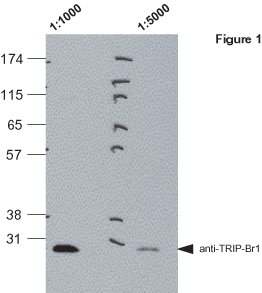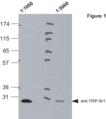Product Details
| Alternative Name: | Transcriptional regulator interacting with the PHD-bromodomain 1, SEI-1, SERTA domain-containing protein 1, CDK4-binding protein p34SEI1 |
| |
| Clone: | TB1-27/2 |
| |
| Host: | Mouse |
| |
| Isotype: | IgG2a |
| |
| Immunogen: | Synthetic peptide corresponding to aa 27-42 (D27PGHAAVAQAPPAVAS42) of human TRIP-Br1 [SEI-1]. |
| |
| UniProt ID: | Q9UHV2 |
| |
| Source: | Purified from hybridoma tissue culture supernatant. |
| |
| Species reactivity: | Human, Mouse
Monkey, Porcine
|
| |
| Applications: | IHC, IP, WB
|
| |
| Recommended Dilutions/Conditions: | Immunohistochemistry (1:200)
Western Blot (1:1,000-1:5,000)
Suggested dilutions/conditions may not be available for all applications.
Optimal conditions must be determined individually for each application. |
| |
| Formulation: | Liquid. In PBS containing 0.02% sodium azide. |
| |
| Handling: | Avoid freeze/thaw cycles. After opening, prepare aliquots and store at -20°C. |
| |
| Shipping: | Blue Ice |
| |
| Short Term Storage: | +4°C |
| |
| Long Term Storage: | -20°C |
| |
| Scientific Background: | TRIP-Br1 (SEI-1) functions as physiological integrator of transcriptional regulatory signals at E2F-responsive promoters to ensure proper execution of E2F-dependent cell cycle progression. TRIP-Br1 is defined as an oncogene. |
| |
| Regulatory Status: | RUO - Research Use Only |
| |

Figure 1: Western blot analysis of pig kidney lysates (LLC-PK1) using MAb to TRIP-Br1 (TB1-27/2) (Prod. No.
ALX-804-645) at 1:1’000 and 1:5’000."
Please mouse over
Product Literature References
SERTAD1 Sensitizes Breast Cancer Cells to Doxorubicin and Promotes Lysosomal Protein Biosynthesis: H.A. Nguyen, et al.; Biomedicines
10, 1148 (2022),
Abstract;
Inhibitory role of TRIP-Br1/XIAP in necroptosis under nutrient/serum starvation: Z. Sandag, et al.; Mol. Cells
43, 236 (2020),
Abstract;
Full Text
Exploiting the TRIP-Br family of cell cycle regulatory proteins as chemotherapeutic drug targets in human cancer: Z.J. Zang, et al.; Cancer Biol. Ther.
6, 712 (2007),
Abstract;
General Literature References
CDCA4 is an E2F transcription factor family-induced nuclear factor that regulates E2F-dependent transcriptional activation and cell proliferation: R. Hayashi, et al.; J. Biol. Chem.
281, 35633 (2006),
Abstract;
Full Text
Dissection of CDK4-binding and transactivation activities of p34(SEI-1) and comparison between functions of p34(SEI-1) and p16(INK4A): J. Li, et al.; Biochemistry
44, 13246 (2005),
Abstract;
SEI family of nuclear factors regulates p53-dependent transcriptional activation: R. Watanabe-Fukunaga, et al.; Genes Cells
10, 851 (2005),
Abstract;
Full Text
Expression of a human SOCS protein, HSOCP-1, in peripheral blood eosinophils from patients with atopic dermatitis: K. Ogawa, et al.; Int. Arch. Allergy Immunol.
134 Suppl 1, 2 (2004),
Abstract;
The nuclear protein p34SEI-1 regulates the kinase activity of cyclin-dependent kinase 4 in a concentration-dependent manner: J. Li, et al.; Biochemistry
43, 4394 (2004),
Abstract;
TRIP-Br links E2F to novel functions in the regulation of cyclin E expression during cell cycle progression and in the maintenance of genomic stability: K.G. Sim, et al.; Cell Cycle
3, 1296 (2004),
Abstract;
Regulation of CREB-mediated transcription by association of CDK4 binding protein p34SEI-1 with CBP: T. Hirose, et al.; Int. J. Mol. Med.
11, 705 (2003),
Abstract;
The Drosophila gene taranis encodes a novel trithorax group member potentially linked to the cell cycle regulatory apparatus: S. Calgaro, et al.; Genetics
160, 547 (2002),
Abstract;
Full Text
TRIP-Br: a novel family of PHD zinc finger- and bromodomain-interacting proteins that regulate the transcriptional activity of E2F-1/DP-1: S.I. Hsu, et al.; EMBO J.
20, 2273 (2001),
Abstract;
Full Text
RBT1, a novel transcriptional co-activator, binds the second subunit of replication protein A: J.M. Cho, et al.; Nucl. Acids Res.
28, 3478 (2000),
Abstract;
Full Text










